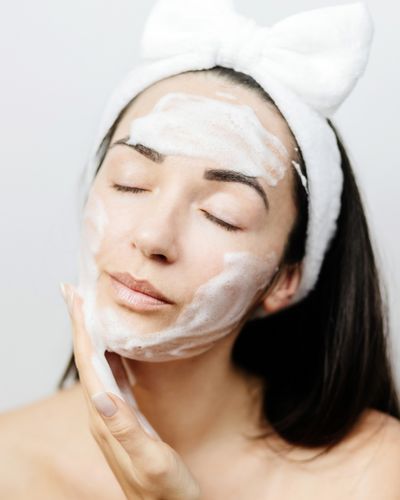Exfoliation happens regularly in a good self/skincare regimen.
Some people do it once or twice, or if you have oily skin, you may have probably heard that you could even dare to do it up to three times a week.
By exfoliating your skin, you are removing the build-up of dead skin cells and any lingering dirt that can cause breakouts on the surface of your skin. This reveals a soft, smooth skin layer that has a nice radiance and appears healthy. That’s a good enough reason to do it often.
But how often should you exfoliate your face (so you get all the benefits without the irritation)?
While regular exfoliation should be a part of your skincare routine, this is definitely a process that needs to be reserved for no more than 2-3 times a week.
Let’s now get into the science of how often you should exfoliate your skin and how to choose the best exfoliator for your skin.

What Are Skin Cells?
I’m sure you’ve heard about dead skin cells already and that you should every once in a while help your skin get rid of them by using an exfoliator.
But where do these skin cells come from? And how do they end up dying on the surface of your skin?
The surface of our skin is called epidermis. This is a very thin layer that is made up of five even thinner layers.
New cells are made in the lower layers of the epidermis by receiving nutrients and oxygen from your blood, and that’s where they are the youngest.
But as the cells travel through the layers of the epidermis, closer to the surface and further from the nutrients supply, they mature.
Over the course of around four weeks, they make their way to the surface, become hard, and replace the dead skin cells as they are shed.
This means that your skin is constantly regenerating and the skin you have today is not the same you had four weeks ago.
Which is kinda cool, but why am I telling you this?
Because in order to understand how exfoliation works, it is important to know how your skin regenerates and how the products you apply on your face help to keep it smooth and radiant.
What Does Exfoliation Do?

Your skin is constantly shedding dead skin cells. When this happens, smoother skin cells push their way up to the surface.
However, as you age, the rate at which your body sheds dead skin cells begins to slow down.
That is where exfoliation comes in to help.
In the simplest terms, exfoliation is physically or chemically removing those dead skin cells in order to speed up the process and help your skin appear younger, healthy, and radiant.
Another important thing is that sometimes, the dead skin cells can remain trapped on the skin’s surface and build-up on top of each other.
This can cause clogging of your pores, rough skin texture, dull skin appearance, and can lead to bacteria and dirt joining along and doing its part to cause acne breakouts on your skin.
We exfoliate to ensure the dead skin cells are swept away and prevent this from happening.
There are two types of exfoliating products on the market which are the following:
- Physical exfoliators (scrubs) – that work against the top layers of the skin to remove the dead skin cells.
- Chemical exfoliators – that instead of physically sloughing the dead skin cells away, they work on dissolving the glue or bonds that hold dead skin cells together so they can shed easily.
Chemical exfoliators also penetrate deeper into the skin and can be a great option for deep congestions, or skins that get easily irritated from physical exfoliators.
While you may be opposed to the word “chemical” today’s article is going to be all about teaching you that how these agents work and why should you consider opting for a chemical exfoliator rather than a physical one.
Is Chemical Exfoliation Good For Skin?
Unlike scrubs, which have grainy ingredients and work to slough off the build-up of dead skin cells on the very top layer of your skin.
Chemical exfoliators, on the other hand, use ingredients with low pH that are called acids or enzymes that due to their small molecular size can easily travel deeper into the skin layers and gently break down the sugars that act as bonds between cells.
This causes the cells to loosen and slough off without irritating the skin like the harsh granules from a physical scrub can often do.
So essentially, the only scary thing about “chemical exfoliators” is their weird name.
They are designed for the most sensitive skins that often get irritated while using a scrub.
3 Types of Chemical Exfoliators.
There are three types of chemical exfoliating agents:
1. Alpha Hydroxy Acids (AHAs)
These acids are derived from fruit, sugars, or milk.
Using alpha hydroxy acids can help loosen dead skin cells, fade pigmentation and dark spots, brighten the skin, and make the top layer of your skin to appear youthful, radiant, and refreshed.
They can help your skin feel softer and look more refined and smooth.
Alpha hydroxy acids come in a variety of concentrations and molecular sizes.
2. Beta Hydroxy Acids (BHAs)
Salicylic acid is the only BHA and it is an oil-soluble substance that’s naturally derived from willow tree bark, wintergreen leaves or sweet birch bark.
It is a well-known and very efficient treatment for oily and blemished skin due to its ability to cut through the oil and travel deep into the skin layers to clear the congestion that causes breakouts.
Besides this, it is a powerful keratolytic agent.
This means that salicylic acid is a substance that helps stabilize the abnormally fast shedding of skin cells, which typically happens with conditions like excessive dryness, eczema, seborrheic dermatitis, and keratosis pilaris.
3. Enzymes
Enzymes can help decompose proteins on your skin so that the dead skin cells can be sloughed off easier in order to reveal softer and radiant skin.
What Are The Benefits of Chemical Exfoliation?

Chemical exfoliants have many fantastic skincare benefits and there are many people (myself included) who feel their skincare routine is incomplete without them.
If used in the right way and layered properly one on top of the other, they can give your skin the most strived for glow ever.
There are different levels of chemical exfoliation. These are known as:
- Light chemical peels – that come in lower concentrations and you can safely layer them one of top of the other and use them in your daily skincare routine.
- Deep chemical peels – that are typically used in a professional setting for targetting specific skin concerns.
Essentially, light chemical exfoliants can be safely incorporated in your daily skincare regimen and can combat conditions such as:
- dullness
- texture
- dark spots & patches
- hormonal conditions such as melasma and pigmentation
- sun damage
- fine lines & wrinkles
- excess sebum
- acne
Can You Exfoliate Your Face Every Day?
I would like to answer this question by telling you something no one wants to tell you, and I’m also going to explain why.
The esthetician in me will tell you to do it slowly, get used to one product at a time, don’t mix the two types of hydroxy acids together and so on and so forth.
This is because the esthetician in me doesn’t trust you to be diligent with highly important follow-up products such as applying sunscreen every single morning and reapplying as much as you can of that baby if you are exposing yourself to the sun for a prolonged time.
It happens with all my clients as I happen to live on a tiny island where we have sun all-year-round and the most common skin concern my clients face is pigmentation due to the sun.
That tells me that I cannot trust them by giving them a cocktail of AHAs & BHAs and tell them to exfoliate daily, knowing that they will probably forget to apply sunscreen in the morning.
This is important because AHAs and BHAs can make your skin sensitive to the sun. And it can easily turn around and bite you because constant sun exposure that is not being followed with adequate sun protection can cause pigmentation.
But in reality, once you do your research and try out different products, and essentially figure out what works best for you and your skin type – you can exfoliate daily.
I exfoliate twice a day using my Glycolic Acid Activator by Medik8 which is a mild AHA toner-like product. And on days when I feel like using salicylic acid, I do so in the evening.
Needless to say, the salespeople always try to make it a point that I shouldn’t do it more than three times a week. But I have found this to be working perfectly for my skin for months now.
So it is really all about experimenting with your skin by using your products and being responsible with applying adequate follow-up products. The ground rule is to always start slow, with lower concentrations and always followed by sunscreen in the morning.
But as you progress further into chemically exfoliating your skin, you will be able to realize for yourself how often do you need it.
Can Exfoliating Every Day Cause Acne?
If you suffer from acne and need to exfoliate your skin, right off the bat I am going to tell you to ditch a physical scrub and opt for a chemical exfoliator.
Skin purging is worsening of your skin condition brought on by a change in your skincare regimen. It primarily happens when you start using a product that contains ingredients that promote cellular turnover.
This can happen when you introduce a chemical exfoliant that contains salicylic acid in your skincare regimen as a result of accelerated cellular turnover.
Chemical exfoliants require an adjustment period before they can provide the expected results and encourage a faster cell turnover rate, resulting in a faster acne formation cycle.
Purging forces existing acne or smaller pimples to mature quickly. If you have clogged pores, they may turn into pimples and active acne while smaller pimples develop into larger ones.
This initial breakout simply means that the product is working by clearing all the gunk stuck in your pores and forces it to come out on the surface sooner.
It typically clears up within two to six weeks, depending on the severity of the congestion before the skin finally improves.
Once the initial purging process is over, your pores are left clean and open for sebum to travel freely to the surface instead of remaining trapped inside the pore where it essentially causes the breakout.
While it may appear as if your skin is having a negative reaction, this is probably not the case. After a while, it is likely that your skin will adapt to and respond positively to the new ingredients.
This happens with products that accelerate cellular turnover and regeneration, and these are called actives. Some of them are:
Does Exfoliating Help Blackheads?
Blackheads or open comedones are the mildest form of acne and these can be very stubborn and difficult to get rid of.
They can develop at any stage of your life but are typically common with teenagers during the time of puberty where hormones are usually out of balance.
The hormone androgen directly stimulates the sebaceous glands to produce more sebum and clog the pores. This then remains in the pore where it hardens and forms a yellowish plug.
The “head” remains open on the surface of the skin and it turns black due to exposure of air through a process called oxidation.
Salicylic acid is a very effective ingredient that will not only dissolve the hardened sebum inside your pores but will also regulate excess sebum production and prevent blackheads from reappearing.
Physical scrubs can possibly help get rid of blackheads that are closer to the surface, but it is not the ideal treatment for preventing this condition from reappearing.

My name is Simone and I am a certified skin specialist. I created this website to teach my readers how to take great care of their skin and I also like to occasionally share my honest opinions on skincare products I’ve tried. You can learn more about me here.
